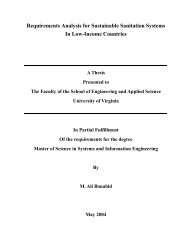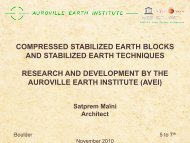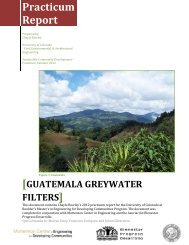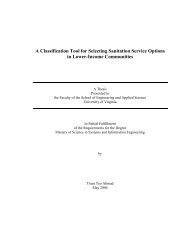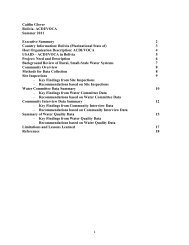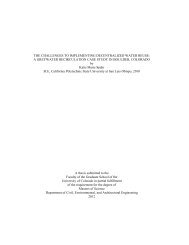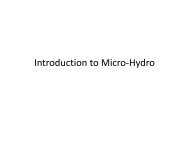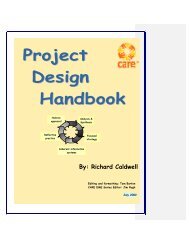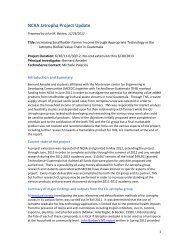SCEBs - University of Colorado Boulder
SCEBs - University of Colorado Boulder
SCEBs - University of Colorado Boulder
You also want an ePaper? Increase the reach of your titles
YUMPU automatically turns print PDFs into web optimized ePapers that Google loves.
The equation <strong>of</strong> the trend-line was used to calculate the E value for a prism with<br />
an aspect ratio <strong>of</strong> 2 as follows:<br />
# <strong>of</strong> Stacked<br />
Blocks in Prism<br />
(height = 0.9375)<br />
ksi<br />
1.<br />
2111<br />
1.<br />
2111<br />
y 16.<br />
502<br />
x 16.<br />
502<br />
2.<br />
0 7.<br />
1<br />
Aspect<br />
Ratio<br />
Test Data<br />
E [ksi]<br />
Calculated E<br />
from Trend-line<br />
[psi]<br />
Prism E value/ E<br />
value for an aspect<br />
ratio <strong>of</strong> 2<br />
1 0.37 54.9 55.4 7.78<br />
2 0.74 23.7 23.9 3.36<br />
3 1.10 16.5 14.7 2.06<br />
4 1.47 9.6 10.3 1.45<br />
Table 5.4:<br />
The last column in Table 5.4 gives the values <strong>of</strong> the ratio between each prism‟s E<br />
value and the E value <strong>of</strong> a prism with an aspect ratio <strong>of</strong> 2.0.<br />
5.3. On-site Testing<br />
5.3.1. Shop Press<br />
A simple set-up that can be used for on-site modulus <strong>of</strong> rupture (MOR) testing is<br />
shown in Figure 5.23. It consists <strong>of</strong> a 10-ton shop press ($300 value in the U.S.) fitted<br />
with a pressure gauge to record the applied pressure at failure. After loading the block<br />
into the frame a hydraulic pump is used to steadily apply force until failure. The<br />
recorded pressure at failure is converted to a force, which is used in the calculation <strong>of</strong> the<br />
specimen‟s MOR (Section 3.9). As mentioned in Section 5.1.3, the shop press pictured is<br />
also able to apply the force required to test the stabilized compressed earth cylinders.<br />
The ability to perform on-site quality control tests allows for more frequent<br />
testing <strong>of</strong> block specimens without drastically increasing project costs. Testing earthen<br />
blocks in a laboratory facility can be expensive due to transportation costs, laboratory<br />
fees, and time lost waiting for results. On-site testing is also beneficial during the process<br />
74



